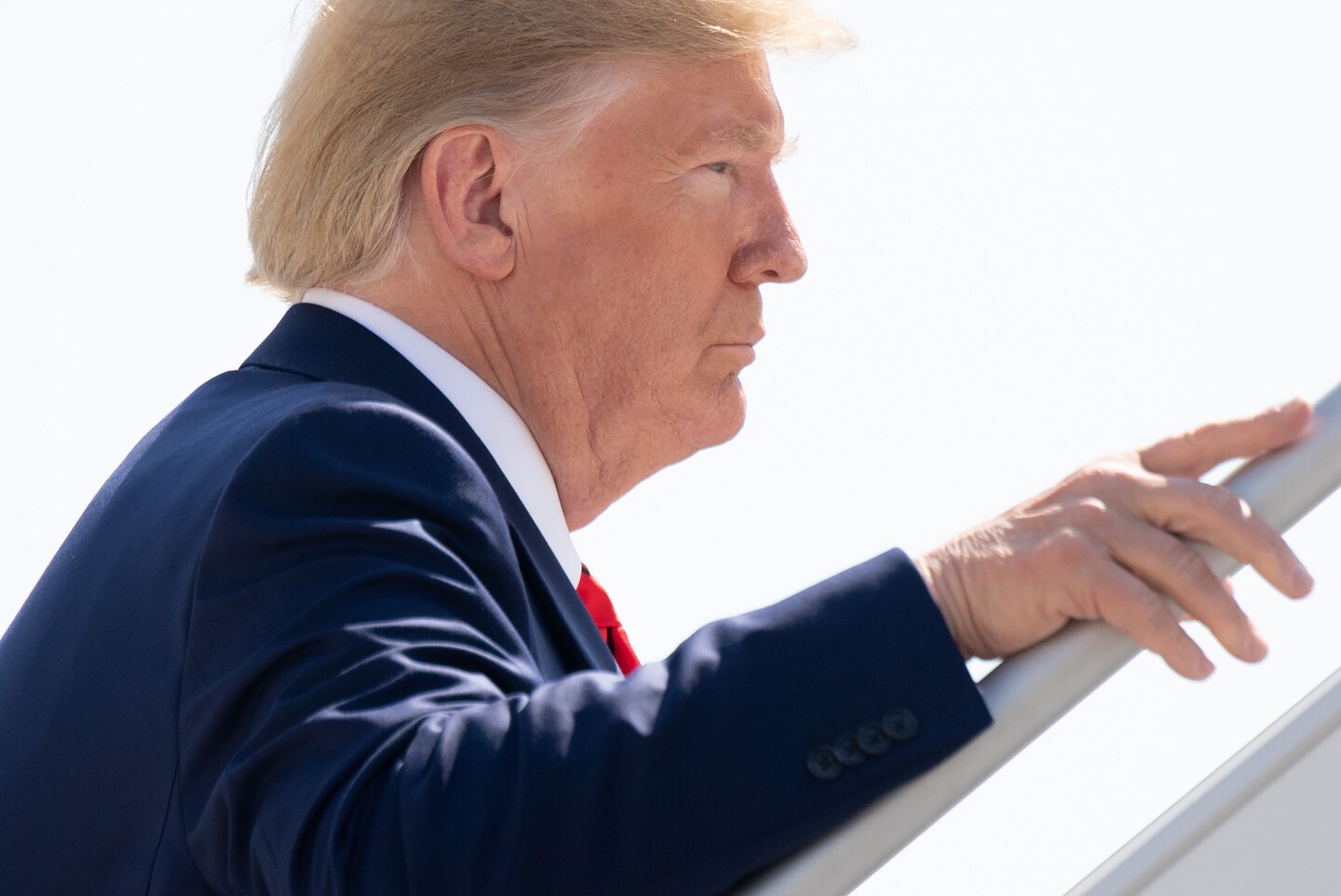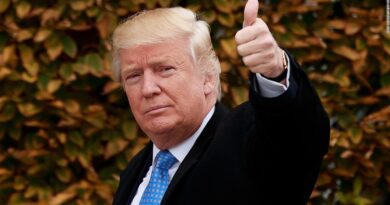Perspective | How far-right conspiracy theories informed Trump’s Ukraine call

Random babbling? Hardly. The theory not only provides fodder for fundraising and fuel for Trump’s base, but by evoking it, Trump follows a pattern he has maintained in office: disregarding the consensus of U.S. intelligence officials, as well as reputable news reporting, in favor of hyperpartisan sophistry. By folding fringe conspiracy theories into administrative action, Trump is giving the theories new life and, with his words and actions on the national stage, has inflamed threats to national security, emboldened extreme fringe figures and exhausted government resources. His affinity for the far-flung has directly influenced his policy decisions and the alliances his administration has cultivated since taking office.
In the account of the conversation that was released by the White House, Trump name-dropped CrowdStrike, the cybersecurity firm the Democratic National Committee hired to conduct an investigation surrounding the hacking of its email servers in 2016. According to the memo of the conversation, Trump asked Zelensky to “do us a favor” and “find out what happened” to a fabled data server that hyperpartisan actors, including longtime Trump ally Roger Stone, have fixated on in an attempt to delegitimize CrowdStrike’s investigation. That investigation found “two separate Russian intelligence-affiliated adversaries present in the DNC network,” and those findings were consistent with analysis by U.S. intelligence officials and independent cybersecurity firms.
“I would like you to do us a favor though because our country has been through a lot and Ukraine knows a lot about it. I would like you to find out what happened with this whole situation with Ukraine, they say Crowdstrike … I guess you have one of your wealthy people … The server, they say Ukraine has it,” Trump told Zelensky, according to the memo.
Trump appears to seek evidence from Ukraine based on a theory holding that there exists a CrowdStrike or DNC server that may contain or lack contents that would prove that the 2016 DNC hack was a hoax created by the Democrats to delegitimize Trump’s defeat of Hillary Clinton in the 2016 presidential election. Trump was clearly referring to this abstract conception of a single server that is not, in fact, missing, and yet it is one of his frequently expressed obsessions as president and effectively opened an avenue for conservative media to rehash theories about the election. In reality, the DNC decommissioned “more than 140 servers” and had to “rebuild at least 11 servers” to secure itself after it was hacked, according to a lawsuit filed by the DNC last year.
“I’ve been asking that for months and months, and I’ve been tweeting it out and calling it out on social media. Where is the server? I want to know, where is the server?” Trump asked as he appeared alongside Russian President Vladimir Putin in Helsinki in 2018, after the Justice Department charged 12 Russian intelligence officers for the DNC hack.
Right-wing conspiracy theorists have for years posited that CrowdStrike fabricated its findings that Russia was behind the hack; they maintain that the fact that the FBI did not seize the DNC’s internal servers is evidence of a coverup. The theory relies on a fundamental misconception about the workings of digital crime; a physical inspection of hardware is not necessary for the conduct of digital forensics and could even damage the devices affected.
Since it was first reported that Russia was suspected of attempting to interfere with the 2016 election, right-wing conspiracy theorists and message-board users have tried to discredit the reality. A right-wing blog called Zero Hedge, rife with conspiracy theories, posted as early as January 2017 that users of the message board 4chan planted fraudulent claims about Russian interference, and that those claims made their way into the intelligence community. Gateway Pundit then repeated the conspiracy theory, New York Magazine reported.
That theory was soon exhausted, and right-wing conspiracy theorists eventually turned their sights to reports that Ukraine sought to influence the 2016 election in favor of Clinton. Conspiracy theorists latched on to false claims that CrowdStrike co-founder Dmitri Alperovitch is Ukrainian and therefore inherited Ukraine’s adversarial position toward Russia. (Alperovitch is a U.S. citizen who was born in Russia.) The false claim was leveraged to bolster accusations that it was Ukraine that had hacked the DNC, possibly to frame Russia.
Conspiracy theorists have also argued that it was an irritated DNC staffer who leaked the emails, and perhaps even murdered DNC staffer Seth Rich. (A mini-verse of right-wing conspiracy theories exists specifically around Rich’s murder, to the dismay of the Rich family, and have been repeated by Fox News host Sean Hannity, a personal friend of Trump’s.)
Fringe right-wing conspiracy theories often graduate from anonymous message boards and social media to the national stage on Trump’s Twitter account and on Fox News; the two often operate symbiotically. It can often take just days for a theory to launder itself as it travels from fringe blog to a presumably reputable social media personality or conservative media outlet and then on to the Fox network.
When a theory is amplified for Trump, it instantly catches fire among his supporters; old theories are re-litigated, and emerging theories erupt. When that happens, national media outlets scramble to demystify the theory, which inadvertently spreads its claims. The debunking often has little effect on theory-believers’ interpretation of the information; after all, any press critical of the president must be “fake news.”
Trump’s request that a foreign official investigate CrowdStrike is yet another example of his proclivity for partisan conspiracy theories over truth, despite the resources at his disposal. Also in the memo recounting the July 25 conversation between Trump and Zelensky, Trump suggests that former vice president Joe Biden “went around bragging that he stopped the prosecution” of his son Hunter Biden, echoing nearly verbatim claims made by Hannity earlier this year. Around the time of Hannity’s claims, Trump’s personal lawyer Rudolph W. Giuliani — who is a bit of a conspiracy theorist himself and is friendly toward Hannity — was reportedly planning to pressure Ukraine to investigate the genesis of the probe of Russian interference in the 2016 election, and also Hunter Biden’s employment by a Ukrainian gas company. Baseless claims about the 2016 election and Joe Biden’s past dealings have been resuscitated in the run-up to the 2020 election as Biden emerged as a Democratic primary front-runner in polls.
Information from the fringes has often served two uses for Trump: inspiring his actions as president and justifying his administrative agenda.
Multimillionaire sex offender Jeffrey Epstein was found dead in his prison cell at the Metropolitan Correctional Center in Manhattan last month, apparently having hanged himself with a bedsheet. The morning of Epstein’s death, Trump shared a video from conservative comedian Terrence Williams that put forward claims that former president Bill Clinton and Hillary Clinton were responsible for Epstein’s death. Medical examiners later determined Epstein’s death was the result of suicide, but Trump defended the retweet to reporters and called for a “full investigation” into Epstein’s death.
The president has also repeated false claims that illegal voting caused him to lose California by millions of votes, despite the fact that no evidence exists to support that claim. The source of such claims relied almost entirely on Internet rumors, PolitiFact determined in 2016, which were initially spread on conspiracy theory websites, including Infowars, and by hyperpartisan actors, including the alt-right-friendly gadfly Milo Yiannopoulos, then employed by Breitbart. Trump leveraged such claims to launch a now-defunct commission on “election integrity” in 2017.
During a Republican fundraising event earlier this year, Trump mentioned a conspiracy theory about windmills causing cancer. That appeared to have originated from some of the most extreme conspiracy theorists online. Derivatives of the theory have appeared on the conspiracy site Natural News. Claims that windmills — or wind turbines that generate green energy — cause cancer aren’t even popular among most conspiracy theorists, the Daily Beast reported at the time, yet the president cited them to advance his administration’s agenda on U.S. fossil fuel production.
Under Trump, the White House reportedly drafted an executive order to address unfounded claims from right-wing social media personalities who say they have been censored by social media companies on the basis of their political beliefs, ignoring reports showing that conservative content often outperforms progressive content on those platforms.
And last year, Trump tweeted that he had ordered Secretary of State Mike Pompeo to “closely study” land appropriation measures and a string of farm murders in South Africa after watching a segment on Fox News’s “Tucker Carlson Tonight” that presented as fact decades-old white-nationalist propaganda about “white genocide” in the country.
It is difficult to imagine a building in which more reliable information is available than the White House, which is why it’s especially hard to credit that the president of the United States routinely acts on information that comes from right-wing media swamps.


